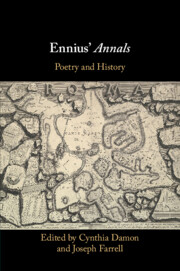Afterword
Published online by Cambridge University Press: 10 April 2020
Summary
Fragments are attractive, and every one of the essays in this volume conveys the attraction that arises from the almost tactile quality of a few words or lines of Ennius, his predecessors, or his contemporaries, as well as from the possibilities of arranging and rearranging those words or lines, from looking at them from the perspective of their past or future, or through the lenses of other texts. Like Lego™, they invite serious play. However, the “fragment” metaphor that we use for the remains of the Annals (and other partly lost works) has influenced and at times distorted the interpretation of those remains. This is to some degree because each fragment, the broken remnant of what was once whole, becomes, to call upon Bill Brown’s theory, its own thing, a thing with its own shape and its own edges; and as such it is often repurposed (broken stone repurposed as fill, potsherd repurposed to cut an umbilical cord), each fragment’s second use, and its third, and so on, differing in varying degrees from that of every other fragment from the same original source.
- Type
- Chapter
- Information
- Ennius' AnnalsPoetry and History, pp. 296 - 309Publisher: Cambridge University PressPrint publication year: 2020



